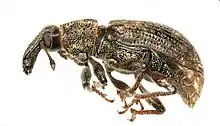Listronotus oregonensis
Listronotus oregonensis, the carrot weevil, is a species of weevil in the beetle family Curculionidae. It is found in North America.[1][2][3]
| Listronotus oregonensis | |
|---|---|
| Scientific classification | |
| Kingdom: | Animalia |
| Phylum: | Arthropoda |
| Class: | Insecta |
| Order: | Coleoptera |
| Family: | Curculionidae |
| Genus: | Listronotus |
| Species: | L. oregonensis |
| Binomial name | |
| Listronotus oregonensis (LeConte, 1857) | |
| Synonyms[1] | |
| |
These two subspecies belong to the species Listronotus oregonensis:
- Listronotus oregonensis oregonensis (LeConte, 1857)
- Listronotus oregonensis tessellatus Casey, 1895
Pest status
This species was first recognized as a pest in 1902 on parsley in Virginia.[4] It mainly attacks cultivated Apiaceae species such as parsley, carrot, celery and dill. By feeding on the root, larvae of the carrot weevil cause direct damage to the vegetable, causing yield losses of up to 50%.[5]
Life cycle

Carrot weevil adults spend the winter in a quiescent state, hiding in the top five centimeters of soil and in weed, grass and debris left in the field, or in field borders.[6] In spring, the female lays her eggs in a cavity that she digs at the base of the petiole of the carrot leaf. The larva passes through four larval stages that will form tunnels through the carrot to feed. The last larval stage leaves the host plant to form the pupa in the soil, from which an adult will emerge a few days later. The carrot weevil performs between one and three generations per year depending on the latitude. However, under unfavorable conditions, this species will undergo a reproductive diapause that delays egg-laying behavior until the following spring.
Pest management
Because this pest has a very low migration capacity, moving mainly by walking, control is made mainly through crop rotation. Insecticide applications that target the adult stage may be necessary when the population density is high. The monitoring of the overwintering generation of adults using carrot-baited traps is an effective means of assessing the level of infestation and predicting the need for insecticide treatments.[7]
Several natural enemies such as micro-organisms, nematodes, predatory insects and parasitoids can attack the carrot weevil. The eggs of the weevil are mainly attacked by parasitoids that are naturally present in the environment, especially by the species Anaphes victus and A. listronoti.[8][9] Smaller species of ground beetles, such as Bembidion quadrimaculatum and Clivina fossor, can also attack weevil eggs.[10] In addition, pupae that are found under the ground and adults that move on the litter are mainly attacked by larger ground beetles[11] The nematode Bradynema listronotii has the ability to inhibit the reproductive system of the female, reducing the oviposition on host plants.[12]
References
- "Listronotus oregonensis Report". Integrated Taxonomic Information System. Retrieved 2019-09-24.
- "Listronotus oregonensis". GBIF. Retrieved 2019-09-24.
- "Listronotus oregonensis species Information". BugGuide.net. Retrieved 2019-09-24.
- Pepper, Bailey B.; Hagmann, Lyle E. (1938-04-01). "The Carrot Weevil, Listronotus latiusculus (Boh.), A New Pest on Celery1". Journal of Economic Entomology. 31 (2): 262–266. doi:10.1093/jee/31.2.262. ISSN 1938-291X.
- Boivin, G. (2013), "Listronotus oregonensis (LeConte), carrot weevil (Coleoptera: Curculionidae).", Biological control programmes in Canada 2001-2012, CABI, pp. 214–220, doi:10.1079/9781780642574.0214, ISBN 978-1-78064-257-4
- Grafius, E.; Collins, R. D. (1986-02-01). "Overwintering Sites and Survival of the Carrot Weevil, Listronotus oregonensis (Coleoptera: Curculionidae)". Environmental Entomology. 15 (1): 113–117. doi:10.1093/ee/15.1.113. ISSN 1938-2936.
- Boivin, Guy (1985-08-01). "EVALUATION OF MONITORING TECHNIQUES FOR THE CARROT WEEVIL, LISTRONOTUS OREGONENSIS (COLEOPTERA: CURCULIONIDAE)". The Canadian Entomologist. 117 (8): 927–933. doi:10.4039/ent117927-8. ISSN 0008-347X.
- Hopper, L.R.E.; Le Blanc, J.-P.R.; Boivin, G. (2005-04-12). "The detection of Anaphes sp. nov. [Hymenoptera: Mymaridae], an egg parasitoid of the carrot weevil in Nova Scotia". Phytoprotection. 77 (2): 79–82. doi:10.7202/706103ar. ISSN 1710-1603.
- Huber, John T.; Côté, Sylvain; Boivin, Guy (1997-09-01). "DESCRIPTION OF THREE NEW ANAPHES SPECIES (HYMENOPTERA: MYMARIDAE), EGG PARASITOIDS OF THE CARROT WEEVIL, LISTRONOTUS OREGONENSIS (LECONTE) (COLEOPTERA: CURCULIONIDAE), AND REDESCRIPTION OF ANAPHES SORDIDATUS GIRAULT". The Canadian Entomologist. 129 (5): 959–977. doi:10.4039/ent129959-5. ISSN 0008-347X.
- Baines, Danica; Stewart, Robin; Boivin, Guy (1990-08-01). "Consumption of Carrot Weevil (Coleoptera: Curculionidae) by Five Species of Carabids (Coleoptera: Carabidae) Abundant in Carrot Fields in Southwestern Quebec". Environmental Entomology. 19 (4): 1146–1149. doi:10.1093/ee/19.4.1146. ISSN 1938-2936.
- Zhao, Ding Xin; Boivin, G.; Stewart, R. K. (March 1990). "Consumption of carrot weevil,Listronotus oregonensis, [Coleoptera: Curculionidae] by four species of carabids on host plants in the laboratory". Entomophaga. 35 (1): 57–60. doi:10.1007/bf02374301. ISSN 0013-8959.
- Gagnon, Annie-Ève; Boivin, Guy; Bélair, Guy; Mimee, Benjamin (2018-12-20). "Prevalence of a nematode castrator of the carrot weevil and impact on fecundity and survival". Parasitology. 146 (6): 702–707. doi:10.1017/s0031182018002056. ISSN 0031-1820. PMID 30567618.
Further reading